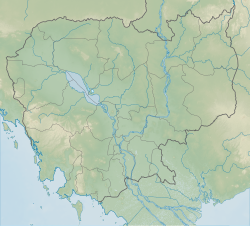
Back Angkor Wat Afrikaans Angkor Wat GSW አንኮር ዋት Amharic Angkor Wat AN अंकोरवाट मंदिर ANP أنغكور وات Arabic انجكور وات ARZ এংকৰ ৱাট Assamese Angkor Wat AST अंकोरवाट मंदिर AWA
អង្គរវត្ត ângkôrvôtt | |
 Front side of the main complex | |
| Location | Siem Reap, Cambodia |
|---|---|
| Coordinates | 13°24′45″N 103°52′0″E / 13.41250°N 103.86667°E |
| Altitude | 65 m (213 ft) |
| History | |
| Builder | Suryavarman II |
| Founded | 1150 |
| Cultures | Khmer Empire |
| Architecture | |
| Architectural styles | Khmer |
| Official name | Angkor |
| Type | Cultural |
| Criteria | i, ii, iii, iv |
| Designated | 1992 (16th session) |
| Reference no. | 668 |
| Region | Asia and the Pacific |
Angkor Wat (/ˌæŋkɔːr ˈwɒt/; Khmer: អង្គរវត្ត, "City/Capital of Temples") is a Hindu-Buddhist temple complex in Cambodia. Located on a site measuring 162.6 hectares (1.6 km2; 401.8 acres) within the ancient Khmer capital city of Angkor, it was originally constructed in 1150 CE as a Hindu temple dedicated to the deity Vishnu. It was later gradually transformed into a Buddhist temple towards the end of the century. Hailed as the largest religious structures in the world, it is one of the best examples of Khmer architecture and a symbol of Cambodia, depicted as a part of the Cambodian national flag.
Angkor Wat was built at the behest of the Khmer king Suryavarman II in the early 12th century in Yaśodharapura (present-day Angkor), the capital of the Khmer Empire, as his state temple and eventual mausoleum. Angkor Wat combines two basic plans of Khmer temple architecture: the temple-mountain and the later galleried temple. It is designed to represent Mount Meru, home of the devas in Hindu mythology and is surrounded by a moat more than 5 km (3.1 mi). Enclosed within an outer wall 3.6 kilometres (2.2 mi) long are three rectangular galleries, each raised above the next. The expansive Temple complex covers an area of 400 acres.[1] At the centre of the temple stands a quincunx of towers. Unlike most Angkorian temples, Angkor Wat is oriented to the west with scholars divided as to the significance of this.
The temple complex fell into disuse before being restored in the 20th century with various international agencies involved in the project.
Restoration was coordinated by the International Coordinating Committee for the Safeguarding and Development of the Historic Site of Angkor (ICC-Angkor), established in 1993 under UNESCO. Major contributors included France (via the École française d’Extrême-Orient), Japan (JASA), India (Archaeological Survey of India), Germany (GACP), the United States (World Monuments Fund), South Korea, China, and Italy.[1]
The temple is admired for the grandeur and harmony of the architecture, its extensive bas-reliefs and devatas adorning its walls. The Angkor area was designated as a UNESCO World Heritage Site in 1992. The Angkor Wat is a major tourist attraction and attracts more than 2.5 million visitors every year.
- ^ "Angkor Wat". Britannica. Retrieved 14 July 2025.
